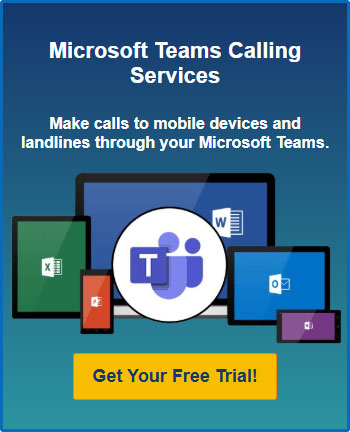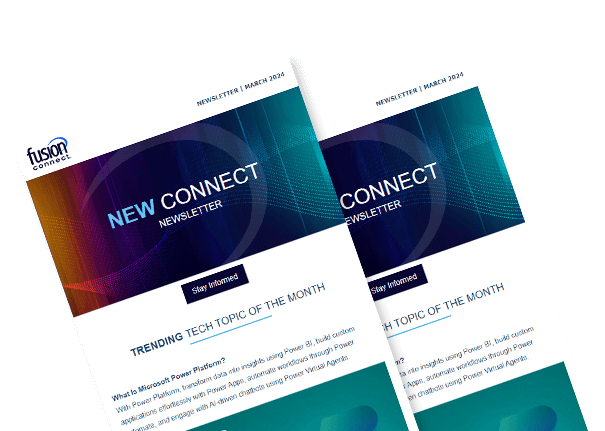How to Add Microsoft Teams to Outlook
Posted on September 30, 2025 by Fusion Connect
We have all been there… you are trying to set up a quick Teams meeting, but the button in Outlook is nowhere to be found. What should take 10 seconds turns into a mini troubleshooting session. Frustrating, right? The good news: Once Outlook and Teams are connected properly, scheduling becomes effortless. Microsoft Teams and Outlook are built to work side by side. When connected properly, they create a smarter workflow that helps teams collaborate faster and with fewer distractions.
Still, getting the Teams meeting add-in to show up in Outlook isn't always simple. Whether it's missing from the toolbar or not working at all, it’s often a matter of the right settings—or the right version. This quick guide will walk IT leaders, tech managers and infrastructure directors through what to check, how to fix common issues and why keeping Microsoft 365 services properly licensed helps avoid these headaches in the first place.
Why Connecting Teams with Outlook Improves Daily Workflows
Bringing Microsoft Teams and Microsoft Outlook together creates a unified collaboration space that makes scheduling faster and more intuitive. When the Teams meeting option is available directly from the Outlook calendar, employees no longer need to switch between tools just to set up a meeting. This integration improves meeting efficiency by giving users one consistent way to schedule, join, and manage meetings. That simple button makes a big difference. It means: no more flipping between apps to grab the right meeting link, fewer back and forth emails when trying to coordinate schedules, and a consistent one-click way to set up or join meetings.
For IT leaders, this isn’t just about convenience. It’s about cutting down on support tickets, standardizing workflows, and making sure collaboration tools actually work together, so employees can spend less time troubleshooting.
Unified Scheduling Builds Smarter Collaboration
Integrated scheduling allows teams to align faster without needing to toggle between apps. With the Microsoft Teams meeting add-in enabled, a new Teams meeting can be created right from the Outlook calendar. This means employees can book meetings, share the meeting link, and view availability in one place. It minimizes confusion, especially when coordinating across departments or locations.
When organizations use Microsoft 365 to unify messaging, email, and calendar systems, it supports more dependable communication. This helps infrastructure directors manage tools that actually work together, instead of patching around limitations in disconnected systems.
Reducing Friction Improves Day-to-Day Productivity
Here’s the problem: when tools aren’t connected, conversations often stall before they turn into action. Without integration, there's often a delay between conversations and action. Teams chat or video may lead to a decision, but switching to a different app to schedule the meeting slows things down. With Microsoft Outlook and Microsoft Teams working together, users can respond to a conversation and send a meeting invite from the same screen.
Less app switching leads to fewer mistakes—like scheduling the wrong time or missing out on meeting details. Teams features like meeting notifications, online meeting links, and calendar view integration all contribute to a workflow that actually helps people get more done.
Preventing Gaps in Communication Across Teams
Disconnected tools can cause missed meetings, delayed decisions, and frustration among employees. When the Teams add-in is missing or not properly configured, users may not receive the right meeting link or may have trouble joining. This introduces risk to daily operations—especially in remote or hybrid environments.
By keeping the integration active and visible in Outlook desktop apps, IT leaders help maintain consistency across communication tools. Business continuity depends on more than having the right tools—it depends on making sure they work together, every time.
What Causes Teams to Disappear from the Outlook Toolbar?
There are a few reasons the Microsoft Teams meeting add-in might not appear in Microsoft Outlook. It’s often linked to missing com add-ins or outdated versions of either the desktop app or Microsoft 365 suite. Even minor permission mismatches can block features from showing up.
Sometimes the Teams meeting button is simply disabled. This can happen after system updates or policy changes. IT managers should check the Outlook options section under the File tab, then look in the Add-Ins panel. If the Microsoft Teams Meeting Add-in for Microsoft Office appears inactive, re-enabling it may solve the problem.
Steps to Add Teams into Outlook
To connect Microsoft Teams with Microsoft Outlook, both applications must be properly installed and updated. Issues often stem from either outdated software or missing com add-ins. Following the right process helps avoid unnecessary troubleshooting later.
Here’s a step-by-step way to add the Microsoft Teams meeting add-in to Outlook:
- Ensure both apps are up to date:
Make sure the Microsoft Teams desktop app and Microsoft Outlook are updated to the latest version. - Open Outlook and access the Add-ins menu:
In Outlook, click File > Options > Add-ins. - Manage COM Add-ins:
At the bottom of the window, use the Manage dropdown menu to select COM Add-ins, then click Go. - Check the Microsoft Teams Meeting Add-in box:
If the add-in is listed, check the box next to Microsoft Teams Meeting Add-in for Microsoft Office and click OK. - Restart Outlook:
Closing and reopening Outlook allows it to recognize the updated settings. - Reinstall Teams if necessary:
If the add-in doesn't appear in the list, uninstall and reinstall the Teams desktop app, then repeat the steps above.
For IT leaders managing Microsoft 365 environments on Windows 11, double-check that required permissions are granted under system settings to allow integration between the desktop app and Outlook.
Proven Methods to Maintain a Stable Integration
Quick fixes are good, but prevention is better. Set group policies that allow the Teams add-in to load by default for every user. IT teams managing large environments can use Microsoft 365 admin tools to automate these settings across devices. This prevents recurring troubleshooting and reduces support tickets over time.
Standardizing on one Outlook desktop version across teams also helps. Conflicts often arise when different updates or licenses are applied inconsistently. A central deployment approach supported by regular sync checks keeps Teams and Outlook running together with fewer disruptions.
How a Connected Setup Boosts Team Efficiency
When users can schedule meetings directly from their inbox, there’s less friction in the day. The Outlook calendar becomes a central hub where online meetings, alerts, and meeting details are all stored in one place. It eliminates the need to search for meeting links, manually coordinate availability, or open multiple apps to get work done. Teams features become more accessible and easier to use during meeting preparation.
Supporting Multi-Location Teams with Centralized Access
For organizations with multiple branches or remote offices, keeping everyone aligned is a constant challenge. A connected setup between Microsoft Teams and Microsoft Outlook enables cross-location collaboration by standardizing how meetings are scheduled and accessed. Whether a team member is in the office, at another site, or traveling, they can rely on consistent meeting workflows through the Outlook calendar and Teams meeting button.
Using Microsoft 365 as a foundation, IT leaders can provide reliable access to the same tools, permissions, and integrations across locations. This minimizes support overhead and creates predictability in how users schedule and join meetings, regardless of where they are.
Enabling the Remote and Hybrid Workforce
A connected Microsoft Teams and Outlook environment is especially beneficial for hybrid or remote workforces. Employees working from home need quick access to online meetings without relying on manual workarounds or delayed IT support. When the Teams meeting add-in is active, scheduling is as easy as opening Outlook, selecting the calendar view, and clicking “New Teams Meeting.”
The integration helps maintain momentum in remote environments. It supports real-time notifications, synchronized meeting invites, and calendar coordination. With fewer manual steps, users stay engaged and productive—without needing to ask for help or guess whether they’ve missed an update.
Centralizing Controls for Better Oversight
Infrastructure and IT managers benefit from a connected system because it simplifies administration. With Microsoft 365, permissions, integration settings, and user access can be managed centrally. This removes guesswork from troubleshooting and allows teams to scale collaboration tools confidently across departments.
Instead of relying on multiple platforms with fragmented workflows, organizations can use Teams and Outlook together to create a reliable, repeatable process for internal and external meetings.
Smarter Ways to License Microsoft Applications and Cloud Solutions
A successful Teams and Outlook integration depends on having the right Microsoft Licensing in place. Without it, even well-configured systems can run into missing features or compatibility issues. This is where Fusion Connect brings clarity and support.
Fusion Connect helps organizations license Microsoft products—including Microsoft 365 and Microsoft Teams—based on what they actually use. Flexible models let you scale up or down without committing to long-term plans you may not need. With U.S.-based support ready around the clock, you don’t have to spend hours working through Microsoft support queues.
Whether it’s configuring Microsoft Teams meeting add-ins, setting up the Outlook desktop for broader use, or aligning your environment with Microsoft Office best practices, Fusion Connect supports your IT strategy through personalized licensing expertise. Explore Microsoft Licensing with Fusion Connect to get started.
Speak to Our Tech Experts
We can help your business optimize your Microsoft investment. Ask us how!
Fusion Connect is a Microsoft Cloud Solution Provider.

Originally Posted on August 04, 2023 by Fusion Connect.



